Leave your world behind to uncover this long tradition that remains sacred in Japan.
Most people travel to Japan with a vision that includes “experiencing the real culture.” Yet, they fail to realize that many true Japanese traditions live and breathe most authentically outside of Japan’s bustling metropolises.
Take onsen (natural hot springs), for example. The best onsen in Japan leave you in awe while you soak in a hot spring river or in the snowy mountains — and are usually out of the way. Japanese people take pride in the culture of relaxing in natural healing waters, just like the generations before them did.
Along with the more than 3,000 onsen destinations in Japan come heaps of bona fide traditions to explore. Like the chance to try shinyoku (forest bathing) while in secluded nature and experiencing ryokan (Japanese inns) that are often run by families who have survived off the land for generations. This is where you can try out futon-and-tatami-mat living and Japanese food at its realest: meals that are expertly prepared by incorporating regional flavors and methods you cannot find elsewhere.
Leaving your world behind to uncover these onsen leaves you with the realization that these aren’t just getaways — they’re places that many Japanese consider to be sacred. Armed with Jeenie, a new language support app on our smartphones, we headed out to some of Japan’s most scenic onsen.
Here are five of our favorites for that authentic secluded onsen experience.
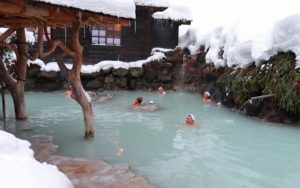
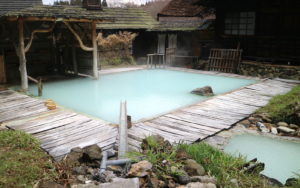
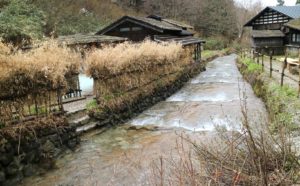
5
Nyuto Onsen
Akita Prefecture
With a cluster of ryokan for overnighters and daytrippers, this northern area in Akita Prefecture has a wealth of some of Japan’s most visually striking onsen. Tsuru-no-yu, in particular, is one of the most classical onsens in Japan and the oldest and most well-known of the Nyutokyo cluster.
Tsuru-no-yu (13 kilometers from Mount Komagatake, an active volcano) is one of the eight hot spring resorts in Nyutokyo. Its location in Towada Hachimantai National Park makes it perfect for trekkers.
At the entrance, an old-fashioned water wheel is furiously pumping away as streams and rivers grace the entire property of old thatched-roof houses and milky-blue onsen water. Its history dates back to the early 1600s when Akita’s feudal lord came to bathe in its therapeutic waters.
On site are several male-only and female-only onsen. But you can also try the tradition of konyoku (mixed-gender bathing) in a rotenburo (outdoor bath) — seriously testing the limits of how comfortable you are naked in front of other people. Game on.
It is more than worth booking a night here, but do so in advance as it is one of the most famous onsen ryokans in the northern region.
Don’t miss
The surrounding area is marked by Japan’s deepest lake, Tazawako, that gives off a blue-green glow throughout the year and is an attraction all its own. Depending on the season, it goes from sapphire to turquoise with the mountains as its backdrop.
- How to get there: The Akita bullet train will take you directly to Tazawako station, but you’re still about an hour out from your destination. Before heading to Tsuru-no-yu, they recommend calling them (Tel: 0187-46-2139) to let them know what bus you are taking. You’ll need to head to the bus stop right outside the station, and board the bus for Nyuto Onsen. Get off at “Arupa Komakusa” bus stop where Tsuru-no-yu will pick you up by shuttle bus free of charge.
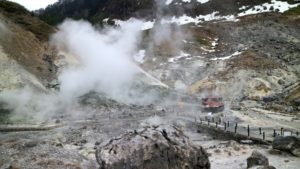
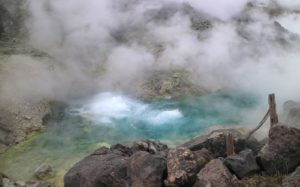
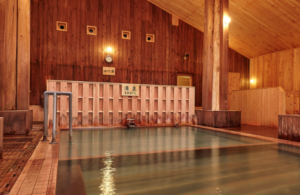
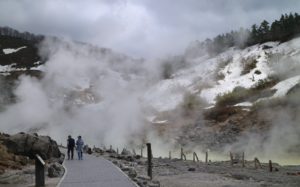
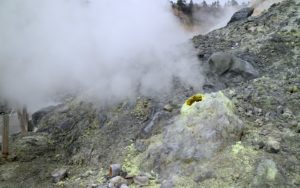
4
Tamagawa Onsen
Akita Prefecture
We cannot mention Akita without digging into a true remote onsen “hotspot” called Tamagawa Onsen. The most sulfuric onsen in Japan, Tamagawa Onsen, is a volcanic river that contains radium running at 98 degrees celsius. Its unique sights, sounds and that distinct sulfuric musk that sticks in your clothes makes it utterly unforgettable.
As you embark on the path marked by impending wafting volcanic haze and rocky surfaces, the sign reads, “Mt. Yakeyama is alive and kicking!” Is it ever. A furious geyser, babbling boiling streams, and billowing puffs of volcanic steam all while trekkers and those who come just to do a “volcanic steam sauna” take in mother earth’s fury for the better. Surreal doesn’t begin to describe this power spot.
At the local shops, you can buy towels and mats to go “bedrock bathing” in the mineral-rich volcanic steam, but just be careful as there are signs warning about the dangers of breathing in too much in one place. Pay attention to this and when all else fails, ask a local (2 taps in the Jeenie app brought up a live translator for instant help with this!), and it should be no problem. In the hot river, you can also boil your own onsen tamago (hard boiled egg in onsen water) and will probably spot guests of the onsen carrying mesh bags of them!
Tamagawa Onsen is one of the top medicinal onsens in Japan to help improve your immune system. After checking out the about 1-kilometer walking path of the volcanic area, do a tamer, but still unique, onsen experience at the local facility. The onsen water is said to help with ailments such as nervous system disorders like rheumatism, diseases of the circulatory system like blood pressure, spinal palsy and cerebral infantile palsy, anemia and various skin diseases.
Don’t miss
At the local onsen facility (玉川温泉 大浴場 / Tamagawa Onsen Large Public Bath), there is a medical advisor on hand for free, although this service is only available in Japanese. (Again, Jeenie helped overcome the language barrier here.)
The onsen is one of the largest we’ve seen. With standing baths, laying baths, steam room and sauna, you’re hit by that cyprus scent as you walk in and can hop into a bath that’s 100 percent Tamagawa Onsen from the source, but it is advised to do this for 10 minutes or less, as it is very strong.
Do an overnight here at the onsen hotel simply called Tamagawa Onsen (which is connected with the bathing facility) or rent a cheap accommodation for around ¥6,000. Note that the ryokan is closed during the winter months from early November to mid-April. One bus stop before it, Shin-Tamagawa bus stop has an alternative ryokan.
- How to get there: The easiest way to get here is to take the bus from Tazawako station to Tamagawa Onsen. Because bus and train times are limited and vary by season, it is best to always check at Tazawako station for times that day.
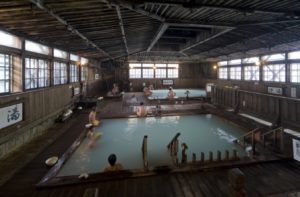
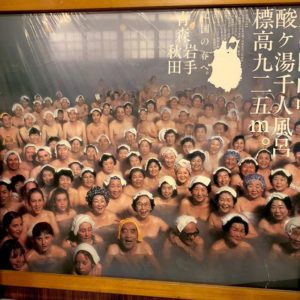
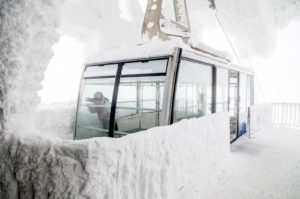
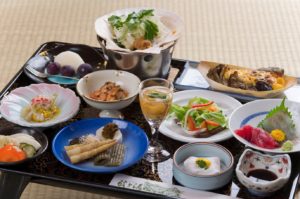
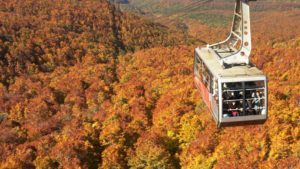
3
Sukayu Onsen
Aomori Prefecture
Sukayu Onsen in Aomori Prefecture may be well known among Japanese but most have only seen it featured on television and in magazines. Located in the remote Hakkoda Mountains, this retreat is one of the snowiest places on earth and is a skier’s paradise from December through February.
Though, no matter the season, there’s no better place to relax than the famed Senninburo (“Bath of 1,000 Bathers”) onsen made of rustic beech wood. This traditional konyoku bath is so big it can fit…well, not quite a thousand people but about 150. Though, if you try to tell a Japanese person that, they’ll swear it really is 1,000! Thankfully, it’s not usually that crowded, but this gigantic wooden bath at around 248 square meters (2,670 square feet) is truly something to behold.
Other than the co-ed one (which does have select gender-only hours), Sukayu Onsen has a female-only and a male-only bath. The baths are all natural with acidic sulfate spring water flowing directly from the source. It is said the water’s healing properties help rheumatoid, nerve pain, intestinal diseases, constipation and asthma.
Don’t miss
Since you traveled all that way, definitely stay at the local ryokan and try the “sukayu soba” and hearty ginger miso bamboo oden (a stew with mountain veggies and dumplings.) In winter, witness the phenomenon of “snow monsters” (trees hauntingly covered in ice and snow that make them look more like mythical figures) at the nearby Hakkoda mountains. Also nearby is the stunningly turquoise Jigokunuma, a brilliant but dangerous-to-swim-in volcanic crater lake.
- How to get there: Take the bullet train to JR Shin-Aomori and from there (or the nearby JR Aomori station), it is about an 80-minute bus ride on the JR Bus Mizuumi-go. Get off at the Sukayu Onsen Mae Stop. Keep in mind that transportation may take longer during winter. If you are traveling by plane, also keep in mind that there is no direct bus from Aomori Airport to Sukayu.
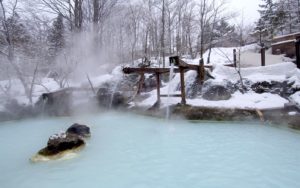
2
Shirahone Onsen
Nagano Prefecture
Deep in the Japan Alps mountain range northwest of Tokyo lies Shirahone, a remote hot spring town that is known as a “secret spa.” Located in a gorgeous valley of Yugawa River of Nagano Prefecture, Shirahone is a majestic area surrounded by lush nature.
The name Shirahone means “white bone” and refers to the cream-colored onsen water that is rich in calcium and magnesium and characterizes the area as an onsen destination. It is said that drinking the water can cure gastrointestinal problems. Of course, you only want to do this where specified, but yes, Japan’s waters are very much pure enough to drink in small amounts.
Awanoyu is the town’s most iconic bath. Both genders are allowed to bathe together in one of the three outdoor baths, as the spring’s blueish milky waters match the hue of the powdery snow in winter.
Don’t miss
Shirahone hosts lots of outdoorsy activities and sightseeing when you’re not soaking in the onsen, with famous ski fields Norikura Highlands and another onsen village called Hirayu.
In the warmer months, Shirahone is also a perfect location to stay and go hiking at the trekking paradise of Kamikochi, as well as venturing into the city of Matsumoto. As Nagano’s main city, you can discover its unique food culture (try basashi, raw horse sashimi!) and check out Japan’s trendy craft beer culture at Matsumoto Brewery. Last but not least witness Matsumoto Castle, one of Japan’s last remaining “original castles.”
Below are navigation directions. Be sure to check the bus timetable before you go. (Jeenie helped here, too, actually. We just flipped the camera around and they helped us interpret the schedule).
- How to get there: Take the bullet train to Nagano station. From there you can take the train (line(s) dependent upon timing) with one transfer or a direct bus for about 1 hour and 20 minutes to Matsumoto station. Next, take a bus from Matsumoto station for about 1 hour, 30 minutes to Shirahone.
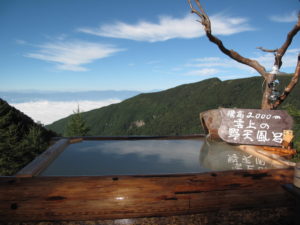
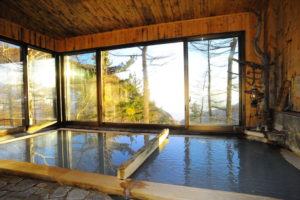
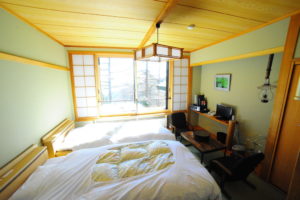
1
Takamine Onsen
Nagano Prefecture
Owned by local Hideo Goto, the fourth generation innkeeper of Takamine Onsen, this spot is a hidden onsen ryokan 2,000 meters above the highlands of Takamine in the mountainous Nagano Prefecture.
From winter to spring, the mountainside transforms from a snowy escape to charming untouched nature accented by clusters of spring wildflowers and yamazakura (wild cherry trees). The ryokan is reminiscent of a log cabin with its interior sporting traditional Japanese decor.
Leaving modern life behind, you’ll be bathing in the clouds at their outdoor bath overlooking the mountains with a star-studded sky at night. But inside, partake in the cyprus baths, as well as a konyoku and there’s even a “drinking corner” where you can taste the local onsen water that is said to have medicinal powers.
If you’re already in Nagano to see one of the most famous attractions, Jigokudani Monkey Park, this is a lovely offshoot for a less touristy onsen experience.
Don’t miss
Don’t leave without partaking in one of Takamine Onsen’s nature tours. Outdoor enthusiasts can enjoy cross-country skiing and snowshoe trekking in winter; hiking along the Asama mountain range from spring to fall; and stargazing through telescopes every night.
- How to get there: Getting there requires some footwork and timing. A bullet train will get you to Sakudaira station. From there, catch the JR Kanto bus (via the Takamine-Kogen line) to Takamine Onsen (approx. 40 minutes). Note: There are only two buses daily from Sakudaira station: 8:35 a.m. and 1:22 p.m.
How the Jeenie app helped us get around Japan
Traveling to these remote locations with help from the Jeenie app was essential to navigate the transport and local culture. The result was a more enjoyable trip with a better understanding of bus routes and travel directions, as well as being able to connect with a handful of locals who were overjoyed to talk with us.
Though locals are always ready and willing to offer help, it can still be a huge leap to get past language barriers. This is true even in Tokyo if you want to go to local places. And who doesn’t want to go to the local gems?!
What’s cool about Jeenie is that it is not a translation machine. You can have real-time conversations and video-chats, and the “Language Jeenies” help you communicate with local people and act as virtual guides who not only know the language and but also cultural do’s and don’ts.
The kind voices on the other end of the line help you figure out some of the more strict rules of the culture like the protocol for onsen, or figuring out transportation options and ryokan stays, for example. Plus, Jeenie is not just for English speakers. You can choose your native language and the language in which you want to find a concierge.
How can I use Jeenie on my trip?
Jeenie is a mobile app that lets travelers get instant access to a Japanese speaker and culture expert. Think “Uber” for language and culture assistance. You can download the app and get connected with real, live humans who can assist with the local language and in cultural situations, too.
The Jeenie app connects you to live interpreters on the screen of your smartphone (or iPad) for a Skype-like call in less than 60 seconds. The service is available 24/7 in any time zone.
Get Jeenie
Available on Android and iOS. The app is free, and after you create an account, your first five minutes are free, so there is no risk to trying the service.
Become a Jeenie
Jeenie aims to bring global awareness to the value of language and language speakers. Join the global Jeenie community and join the network of people who utilize their international language and culture competencies as an income source.
If you are fluent in more than one language, you can become a “Language Jeenie.” You don’t need insurance or equipment — just a phone, a data plan, a professional attitude, and fluent language skills. Work remotely and help customers directly via video-chat or audio to navigate through any experience where language is a challenge.
Sign up to be a Language Jeenie here.
This article was sponsored by Jeenie. Note: The five onsen destinations were chosen by GaijinPot Travel independent of sponsorship.